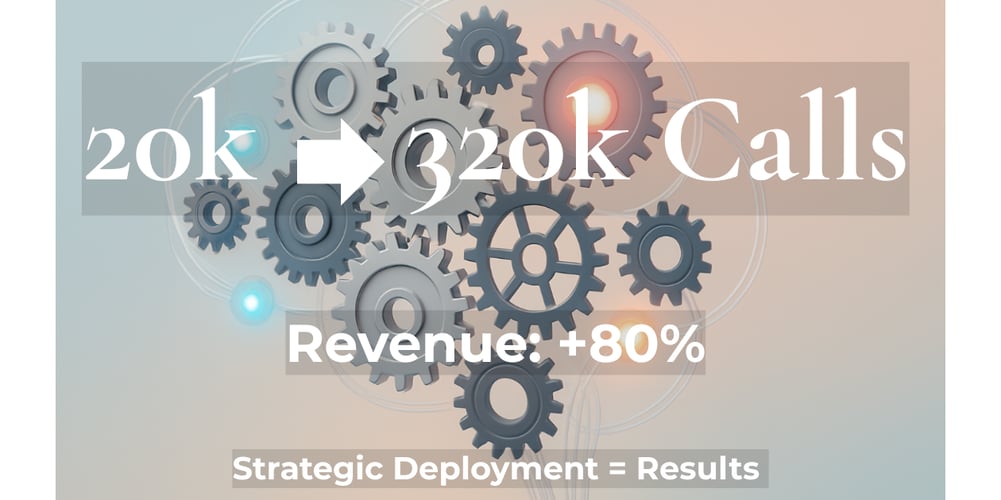16x More Calls, 80% More Revenue: Here's Why
 By
Michal Basha
·
3 minute read
By
Michal Basha
·
3 minute read
We increased collection calls from 20,000 to 320,000 per month.
That's 16 times more volume.
And yes—collections skyrocketed. Revenue increased 80%.
But here's what most people miss: the volume increase alone wouldn't have worked.
What made the difference wasn't calling more. It was calling strategically.
What Everyone Else Saw vs. What I Saw
What everyone else saw: We need more calls. Scale up the team, increase capacity, and dial more numbers.
What I saw: We need structured calling. More volume without strategic architecture = wasted effort and burned customer relationships.
Here's what was actually broken before we scaled:
- Random calling—agents contacted whoever was available, not who should be prioritized
- No account segmentation—high-value accounts treated the same as low-value accounts
- No timing strategy—calling whenever agents were free, not when customers were most likely to pay
- No campaign structure—reactive calling instead of proactive account group prioritization
- No monthly cadence—no system for which accounts to hit early, mid, or late in the billing cycle
You can't just add volume. You have to architect how that volume gets deployed.
This wasn't just a capacity problem. It was a strategic deployment problem.
What Actually Made It Work
I didn't start by hiring more agents or adding more hours. I started by designing the infrastructure that would make those 320,000 calls effective.
Strategic Account Prioritization
Built a system to prioritize account groups by value, payment probability, and optimal contact timing. High-value accounts got called on specific days of the month when payment likelihood was highest. Lower-priority accounts filled gaps, not prime calling windows.
Campaign Architecture by Month Timing
Created a monthly cadence: which account groups to focus on in Week 1 (post-billing), Week 2 (reminder window), Week 3 (urgency window), and Week 4 (final push). Instead of random daily calling, we had strategic weekly campaigns aligned to customer payment cycles.
Technology-Enforced Structure
Integrated systems that ensured agents called the RIGHT accounts at the RIGHT time—not just whoever was next in a random queue. The technology made strategic prioritization automatic, not dependent on agent judgment or manual list management.
Day-of-Week and Time-of-Day Optimization
Mapped which account segments responded best on Tuesdays vs. Thursdays, mornings vs. afternoons. Then built calling schedules that matched agent availability to optimal contact windows by segment.
The Result
Call volume: 20,000 → 320,000 per month (16x increase)
Collection revenue: 80% increase
But here's the critical insight: if we'd scaled to 320,000 RANDOM calls, we would have:
- Burned customer goodwill (over-contacting some, under-contacting others)
- Wasted agent time (calling low-priority accounts at prime times)
- Missed payment windows (calling when customers couldn't or wouldn't pay)
- Created chaos (no one knowing who to call when)
The 16x volume increase worked because we built the strategic architecture first.
Volume amplifies your strategy. If your strategy is random, more volume = more waste.
The Pattern Most Companies Miss
When collection results plateau, the default reaction is, "We need to call more."
And they're half right. More calling CAN work—but only if it's strategically deployed.
Most companies scale volume without scaling strategy:
- Hire more agents, but don't prioritize which accounts they call
- Increase calling hours, but don't optimize for when customers actually answer/pay
- Add more capacity, but don't segment accounts by value and payment likelihood
- Push for more activity, but don't architect campaign timing around billing cycles
The result: 2x the calls, maybe 20% better results. Exhausted team, marginal improvement.
The alternative: 16x the calls with strategic structure = 80% revenue increase.
The difference isn't effort. It's architecture.
The Question That Changes Everything
Before you scale calling volume, ask yourself:
"Do we have the infrastructure to deploy that volume strategically?"
Can you prioritize which accounts get called on which days?
Do you know optimal calling windows by customer segment?
Can you align calling campaigns to monthly payment cycles?
Do you have technology that enforces strategic discipline automatically?
If you answered "no" to any of these, scaling volume will just scale your inefficiency.
You don't have a volume problem. You have a strategic deployment problem.
And that's actually good news—because architecture can be built.
What This Means for You
That 320,000 calls per month wasn't the win. Anyone can dial more numbers.
The win was building the infrastructure that made those calls strategically effective—ensuring the right accounts were prioritized at the right time in the right sequence.
Every operational scaling challenge works the same way. More activity isn't the answer. More STRATEGIC activity is the answer.
Architecture turns volume into results.
In my next post, I'll walk through a recent AI orchestration project where we eliminated cross-functional blind spots by building what I call an 'operational intelligence 'layer'—connecting six different platforms into a single source of truth that made alignment automatic, not aspirational.
But for now, ask yourself: Where in your business are you trying to scale volume without scaling strategy?
Because volume without architecture is just noise.
AED Solution builds performance infrastructure for startups and SMBs—turning operational chaos into systems that deliver measurable, repeatable results.
Ready to scale without breaking what works?
Let's diagnose where your infrastructure needs to be built before you scale.

